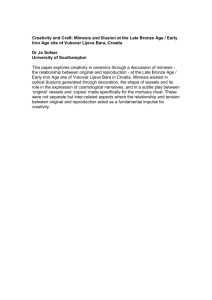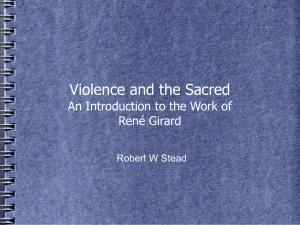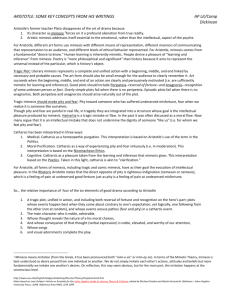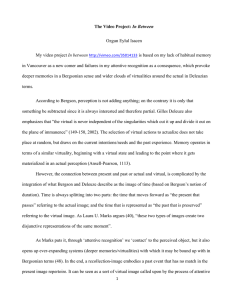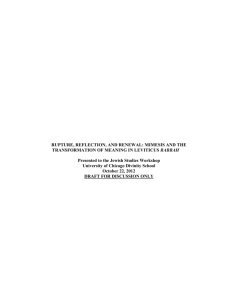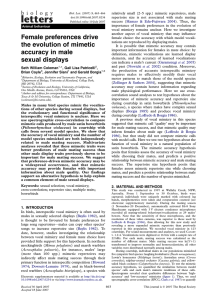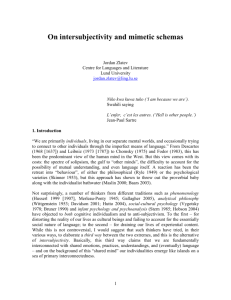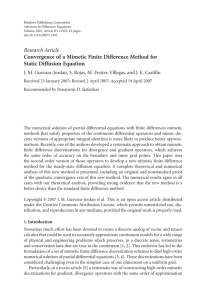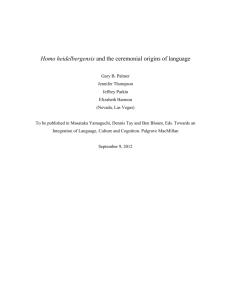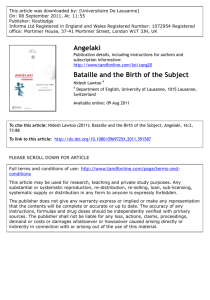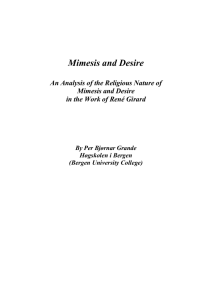The Widening Gyre: Religion, Culture, and Evolution
advertisement
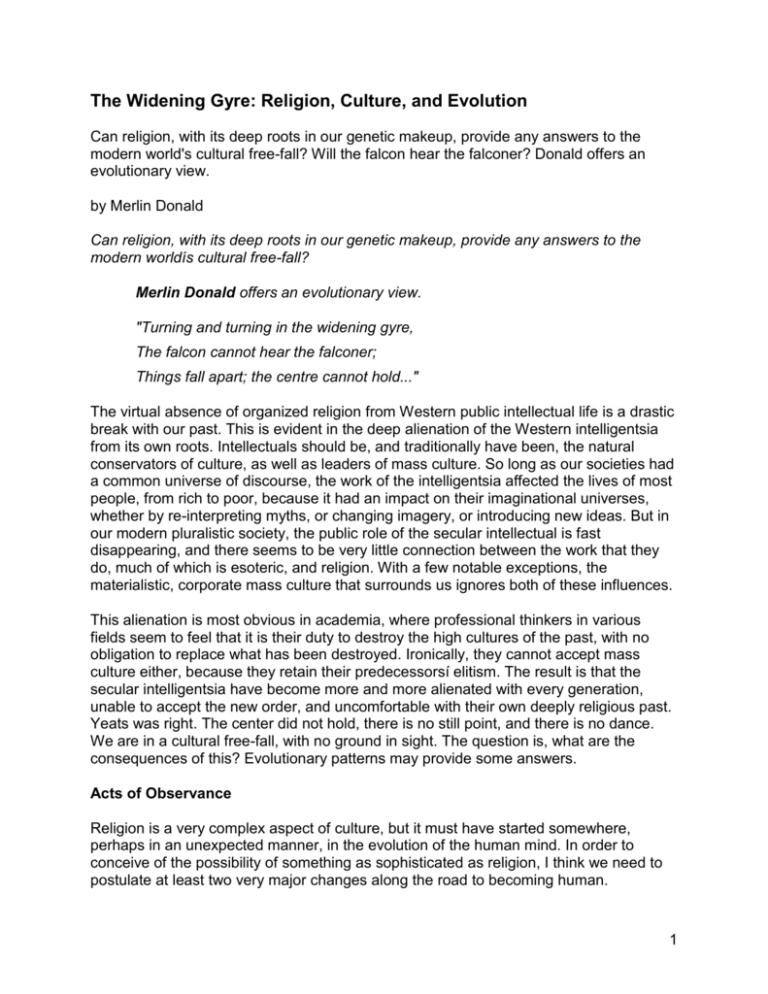
The Widening Gyre: Religion, Culture, and Evolution Can religion, with its deep roots in our genetic makeup, provide any answers to the modern world's cultural free-fall? Will the falcon hear the falconer? Donald offers an evolutionary view. by Merlin Donald Can religion, with its deep roots in our genetic makeup, provide any answers to the modern worldís cultural free-fall? Merlin Donald offers an evolutionary view. "Turning and turning in the widening gyre, The falcon cannot hear the falconer; Things fall apart; the centre cannot hold..." The virtual absence of organized religion from Western public intellectual life is a drastic break with our past. This is evident in the deep alienation of the Western intelligentsia from its own roots. Intellectuals should be, and traditionally have been, the natural conservators of culture, as well as leaders of mass culture. So long as our societies had a common universe of discourse, the work of the intelligentsia affected the lives of most people, from rich to poor, because it had an impact on their imaginational universes, whether by re-interpreting myths, or changing imagery, or introducing new ideas. But in our modern pluralistic society, the public role of the secular intellectual is fast disappearing, and there seems to be very little connection between the work that they do, much of which is esoteric, and religion. With a few notable exceptions, the materialistic, corporate mass culture that surrounds us ignores both of these influences. This alienation is most obvious in academia, where professional thinkers in various fields seem to feel that it is their duty to destroy the high cultures of the past, with no obligation to replace what has been destroyed. Ironically, they cannot accept mass culture either, because they retain their predecessorsí elitism. The result is that the secular intelligentsia have become more and more alienated with every generation, unable to accept the new order, and uncomfortable with their own deeply religious past. Yeats was right. The center did not hold, there is no still point, and there is no dance. We are in a cultural free-fall, with no ground in sight. The question is, what are the consequences of this? Evolutionary patterns may provide some answers. Acts of Observance Religion is a very complex aspect of culture, but it must have started somewhere, perhaps in an unexpected manner, in the evolution of the human mind. In order to conceive of the possibility of something as sophisticated as religion, I think we need to postulate at least two very major changes along the road to becoming human. 1 The first involves mimesis ñ learning by observing a behavior and mimicking it, acting it out, in our own lives. Religions always have a collective side, displayed in various public manifestations. I believe this collective dimension is its most ancient feature, far older than its individualized, or personal, aspects. This suggests that the external aspects of religion arose before they were internalized as the personal morality of believers. This provides us with a powerful theoretical tool, the outside-inside principle. Lev Vygotsky observed that children learn to think from the outside in; that is, they mimic the external actions of speaking and signing first, and only later learn to think silently, in private. This "outsideinside" principle applies to a number of other intellectual skills, including reading. The rule seems to be that public custom comes first and internalization follows, suggesting that some of our most personal thoughts begin as public acts. That same principle applies to the course of human evolution. Humanity must have evolved the externals of culture before we could internalize them, that is, before we could have converted these habits of mind into a silent, private mental world. This is true of religious thought as well, and to understand its emergence in prehistory, we need to consider its deeper roots. Religion is inconceivable outside of the wider culture that surrounds it, and it is always embedded within larger, unspoken customs, which often appear to be highly irrational in their origins. This applies to every religion, even those that have acquired a rational veneer in the form of explicit theologies or philosophies. Religions tend (not without enormous controversy) to fix ritual and custom into standard forms that are widely shared, reaching into every corner of life. Where did this tendency originate? Why would we construct societies, including religions, in this way, enforcing compliance with formal ritual and custom, when there are obviously other ways of achieving social organization? I have speculated, drawing on evidence from various fields, that our communal tendency to establish public customs and conventions is the most ancient component of human culture, stretching back at least two million years. This suggests that certain aspects of human religious culture are much older than language. Before our human ancestors could evolve a capacity as complex as language, they must have evolved prior capacities that allowed them to create simpler conventions, such as ritualized, socially coordinated public behaviors. In this case, acquiring the skill of mimesis would have been a feasible advance from the mentality of our distant predecessors, the Miocene apes. Two of the most distinctive mimetic abilities are re-enacting what we observe, and engaging in role-playing games. Mimesis is a whole-body skill, unique to human beings, whereby we can use our entire bodies as expressive devices. It is the basis of most nonverbal communication, as well as art, craft, dance, and athletics. But more importantly, it is the primordial source of our communal cultural traditions. Early human groups invented customs and shared rituals that enabled them to become, as a group, 2 more effective at toolmaking, food preparation, big-game hunting, migrations, and firetending, among other things. These ritualized patterns were preserved and transmitted by mimetic skill, resulting in very complex patterns of daily life that were determined by convention. Our deepest cultural roots thus lie in collective action, and mimetic thought, from the play-acting of children to the most elaborate rituals of formal religion, is still very much in evidence in the public arena. Speak, Memory An even greater evolutionary event came later in our prehistory, with the emergence of our capacity for speech. This second transition greatly increased the distance between ourselves and our primate cousins. Although the chronology of language evolution is highly debatable, there is some evidence to suggest that it probably emerged in its prototypical form in archaic Homo sapiens, and reached its finished form with the arrival of our own species, about 160,000 years ago. Oral traditions were the inevitable outgrowth of this capacity for language. These traditions may be viewed as gigantic representational conventions that summarize the accumulated wisdom of a people. Such narratives were a great leap from the older framework of simpler ritualized behaviors that had been put in place by mimesis, and served as a kind of collective governor of values, beliefs, and behavior for every member of the society. However, oral traditions did not displace or conflict with mimesis. They incorporated mimetic ritual under a more powerful system of narrative thinking, which produced "mythic" cultures. Myth, in the sense of an authorized set of allegories and narratives, became the ruling construct in such societies. Modern society still preserves much of this structure, and still depends upon mimesis as a sort of elemental social glue. The universal form of traditional religion consists of precisely this: a narrative, a sacred story overlying a deeper core of mimetic traditions ñ rituals and beliefs whose origins lie in the depths of time. These form a "governing hierarchy" that regulates both individual consciousness and public behavior on much of the planet. The Scattering However, modern technological society is now challenging all of this. We are living through a revolution that started with mass literacy, a time of enormous cognitive change. It isnít just that the locus of control has become more diffuse than it once was, or that the public media are fragmenting the memory systems of individuals, shortening our attention spans, and preventing us from gaining any long-term purchase on what is important. These things are certainly a valid cause for concern. However, a deeper event is taking place, a cognitive metamorphosis that has a far-reaching effect on the external distribution of thought and memory. 3 Humanity has broken out of something that we had always lived by: our biological memory system. Oral traditions, including traditional religion, depended heavily on recitation, repetition, and visual imagination, all of which demanded a very personal involvement in the inculcation of tradition. Cultures were preserved entirely in the minds of individuals, that is, within the limits of our inherited biological memory systems. Modern high-tech culture is something altogether different. It is externalized to a far greater degree, controlled by a blizzard of symbols, computers and electronic media. Our highly plastic nervous systems are able to make fine adjustments to each new cognitive reality as it arises; but now the actual operational tools by which we think are changing, and new demands are being made on our brains, which will reshape their basic functional organization (just as we see the "architecture" of a childís mind indelibly shaped in early development). All of this has, and will have, tremendous consequences. Religion ñ both as an institution and as a process of mind ñ has the same evolutionary history as any of our other cultural domains. It weaves a multilayered web of practice, gesture, word, and symbol, by which it influences the way we experience meaning, and how we evaluate the significance of our lives. Just as the public expression of religion reflects our membership in a collective process, we have no choice but to internalize that process in our individual minds. Our spirituality still rests firmly on a mimetic core, and this remains emotionally the most satisfying aspect of religion. The stabilizing virtues of religion still tend to come from the traditional sources of communal practice and belief. But the place of religion in our new society is not easy to define. Our traditional sources of cultural governance are exploding into a million disparate globalized fragments. We seem to be in danger of a parallel fragmentation of personal consciousness, and if so, this could have consequences that may ultimately bear on our integrity as individuals. Perhaps individualism as we have known it in the West will prove to be an ephemeral historical accident, and we will slip back into a comfortable group-think, which would be consistent with much of our history as a species. Perhaps we will move in the opposite direction, towards extreme individualism, to the point of moral anarchy, or even a denial of the external world. Or we may yet find a solution to this bewildering new cultural universe, as we have so many times in the past, and achieve some degree of balance between individualism and collectivity. Perhaps a new religious genius will discover a fantastically clever way to protect the sacred core that has sustained human beings through our turbulent history as a species. We can only hope that this will happen. Merlin Donald is a professor of psychology at Queen's University in Ontario, a Fellow of the Royal Society of Canada and of the Canadian Psychological Association. His most recent book is Origins of the Modern Mind. 4
